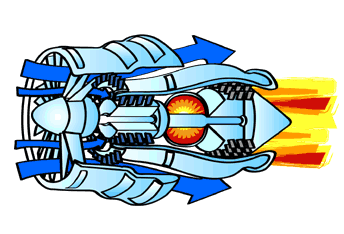A jet engine is designed based on an understanding of Newton's third law: Every action has an equal and opposite reaction. By propagating a force in one direction, an equal and opposite force will propagate in the opposite direction, such as when riding a skateboard a person pushes themselves forward by pushing the ground backwards. In the same way, a jet engine propels itself forward by pushing a blast of air behind it.

A jet engine in action.
The engine accomplishes this through a process of compressing and igniting air. For a standard jet engine, there are 4 main components: a fan, a compressor, a combustor, and a turbine. First, the fan draws air into the engine in large quantities, which the compressor then compresses to a very high pressure. With the gas at such a high pressure, it is injected with highly explosive fuel and ignited to release huge amounts of energy. With the high pressure gas now extremely hot, it quickly evacuates out of the back of the combustor and is forced through a turbine, which it spins. The turbine is connected to the fan, and allows it to continue to turn and bring more air into the engine. Finally, the air escapes the turbine and exits the engine to rapidly expand and cool, pushing the aircraft forward.
Jet engines arose as superior to propeller aircraft due to a mechanical limit of propellers. As the tips of propellers reach the speed of sound, the added thrust becomes smaller and smaller, meaning that to attain greater speeds an entirely new system of propulsion must be used.
Although the theory behind jet propeled engines was understood for centuries, the first functional jet engines were not used until 1939, when the German engineer Hans von Ohain developed the first jet-powered aircraft. Although the jets were far superior to the technology employed by allied air forces, the jets were not available for battle use until 1944, too late to turn the tide of the war. In the aftermath of Germany's defeat, recovered German jets were discovered by the allied forces and used to produce their own jet engines for military use.

The Heinkel He 178, the first jet.
Although jet engines struggled with efficiency for a long time, in the 1970's high-bypass turbofan jet engines were invented and the efficiency began to rival that of propeller engines. Today, jet engines are standard on almost all aircraft besides small consumer craft.
No comments:
Post a Comment